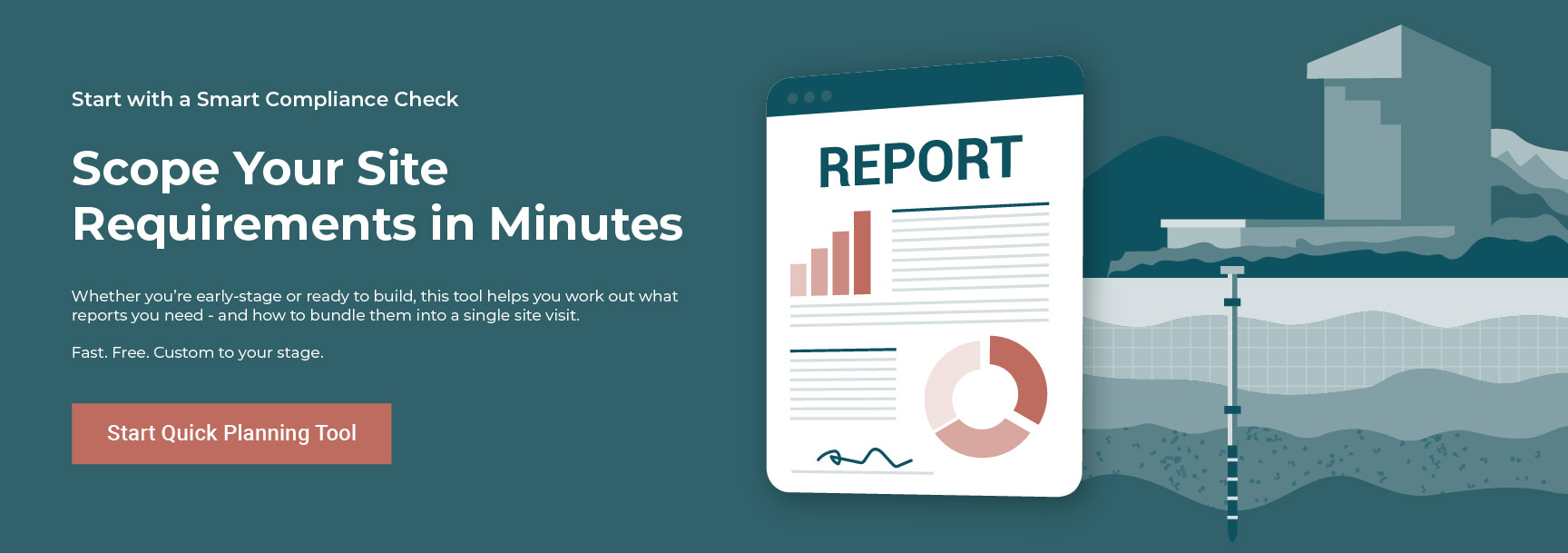Introduction
In today’s high-stakes development landscape, high-risk sites demand more than routine reporting. At Nova Group Pacific we see increasing scrutiny from regulators, lenders and investors around the quality and traceability of compliance records and evidence generated during development, remediation and construction phases.
Whether you are acquiring a brownfield industrial site, managing a large-scale infrastructure project or stepping into land remediation for the first time, your ability to produce a defensible environmental evidence pack supports your environmental due diligence, and satisfies investor expectations — is a strategic asset.
In this article we’ll guide you through:
- What records and documentation you must collect and maintain;
- How to build traceability and prepare for audit processes; and
- Why a strong evidence pack is the key to regulatory compliance and stakeholder confidence.
By following this structured approach you’ll demonstrate your commitment to environmental governance, minimise project risk and strengthen your credibility in the market.
1. Identifying Required Records and Documentation
High-risk developments typically carry legacy issues — contamination, past industrial uses, hazardous materials, underground petroleum storage systems (UPSS) — and future obligations. Building a full evidence pack begins with the right records.
1.1 Environmental Due Diligence Records
Under the umbrella of environmental due diligence, you must be prepared to document:
- Preliminary and detailed site investigations (PSI/DSI) — covering soil, groundwater, surface water assessments.
- Historical land-use reviews and contaminant source mapping.
- Risk assessments for human health, ecological receptors and land-use suitability.
- Site remediation and validation reports.
- Disposal documentation for contaminated soils or waste materials (including reuse or off-site disposal).
1.2 EPA Audit Evidence and Compliance Records
To satisfy an EPA audit (and certainly to provide comfort to investors or lenders), you’ll need to maintain:
- Monitoring data (e.g., groundwater, leachate, gas, surface water).
- Construction environmental management plans (CEMP), dust/noise/vibration monitoring records.
- Asbestos/hazardous materials surveys and removal records.
- UPSS compliance/decommissioning records.
- Licence, permit and regulatory notifications, correspondence with the EPA or local council, clean-up notices or abatement notices.
- Chain-of-custody documentation for samples and lab analyses (NATA accredited where applicable).
1.3 Project-Specific Registers and Traceability
In addition to the above, maintain:
- A document register showing version control, date stamps, sign-offs and distribution list.
- A sampling/timing register (who collected the sample, when, where, what standard was used, which lab, chain of custody).
- An action-tracker for remedial or corrective actions, and evidence of completion (e.g., photographs, field sheets, validation certificates).
- Ensure that all documents are stored in an auditable system (e.g., a secure electronic document management system), with backup and disaster recovery.
Why this matters
If these records are incomplete, inconsistent or lack traceability, you risk:
- Delays in Development Application (DA) approval or construction commencement;
- Weakening of investor or lender confidence;
- Regulatory non-compliance, fines or stoppage;
- Reputational damage and liability for legacy contamination.
By proactively building your evidence pack, you mitigate these risks and enhance your project’s resiliency.
Start with a Smart Compliance Check
Scope Your Site Requirements in Minutes
Whether you're early-stage or ready to build, this tool helps you work out what reports you need and how to bundle them into a single site visit.
Fast. Free. Custom to your stage.
2. Building Traceability and Audit-Ready Processes
Traceability and audit readiness are not optional—they underpin the defensibility of your environmental evidence pack. Let’s break down how we, at Nova Group Pacific, implement an audit-ready process.
2.1 Establishing a Documented Workflow
Start by defining a workflow that maps:
- Site investigation
- Sampling & analysis
- Data interpretation
- Remediation or management intervention
- Validation/confirmation
- Ongoing monitoring & compliance
Assign responsibilities, define timelines, and set triggers for key deliverables (e.g., receipt of lab results, sign-off by a Certified Environmental Practitioner (CEnvP)).
2.2 Sampling and Laboratory Protocols
To ensure traceability:
- Apply a properly designed sampling strategy (e.g., number of boreholes, depths, contaminant suites).
- Use NATA-accredited laboratories and retain certificates of analysis.
- Maintain chain-of-custody forms and preserve raw data and notes.
- Store lab reports, calibration records and QA/QC sheets in the evidence pack.
2.3 Validation and Confirmation
After remediation or management measures, you must confirm the site is suitable for the intended land use. Your validation package must include:
- Final sampling results compared to criteria (for instance, residential vs commercial use).
- Statements of conformance (often signed by a CEnvP).
- Site plans showing sampling locations, extent of remediation, and verification of controls.
2.4 Audit-Friendly Record Keeping
Remember: regulators will look for “who, what, when, where, how”:
- Who performed the work (consultant, contractor, lab)?
- What was done (activities, samples, results)?
- When did it occur (date/time stamps)?
- Where was it performed (map, GPS coordinates, site plan)?
- How was it done (standards, methods, QA/QC)?
Ensure your document register includes:
- Document title/version
- Author and reviewer
- Date created and date issued
- Location of physical/e-file (with backup)
- Retention period and destruction policy (if applicable)
2.5 Chain of Evidence for High-Risk Developments
For high-risk developments (e.g., former industrial/chemical use, fuel storage, landfill interfaces) your evidence pack must go beyond the basics:
- Pre-acquisition due diligence (Phase 1/Phase 2) showing historical risks.
- Documentation of any legacy condition assessments.
- Remediation/works tracking (contractor scopes, site diaries, change orders).
- Post-remediation monitoring program results and trend analysis.
- Communication logs with regulator, stakeholders and community (where relevant).
- Investor and lender disclosures tied to environmental risk.
By building this “chain of evidence”, you provide defensibility against future claims, audits or transaction scrutiny.
3. Ensuring EPA and Investor Confidence
A strong evidence pack does more than satisfy regulatory obligations—it delivers confidence to all stakeholders, including the EPA, investors, lenders, local councils and second-tier service providers.
3.1 Regulatory Confidence
The EPA and similar regulators look for:
- Compliance with statutory obligations (e.g., clean-up notices, licence conditions)
- Completeness of records and clarity of responsibility
- Demonstrable remediation and validation tied to land use
- Robust monitoring and adaptive management
By structuring your evidence pack with transparency, logical flow and traceability, you increase the likelihood of favourable regulator outcomes and minimise risk of non-compliance.
3.2 Investor and Lender Confidence
Investors and lenders are increasingly treating environmental due diligence and environmental compliance records as critical to the value and risk profile of an investment.
Key confidence-drivers include:
- Clear documentation of site status and residual risk
- Validation by qualified environmental practitioners (e.g., CEnvP)
- Transparent remediation and monitoring practices
- Audit-ready pack which can be handed to finance/legal teams
3.3 Best Practice Tips to Maintain Stakeholder Confidence
- Update the evidence pack regularly, especially when monitoring or remediation continues.
- Archive older versions of reports but maintain access and version history.
- Maintain “snapshot” summaries for key decision-makers and board/investor packages.
- Keep a section of the pack dedicated to future land-use constraints, maintenance or long-term monitoring obligations.
- Provide transparency around residual risk levels and land-use suitability.
Conclusion
In high-risk developments the difference between standard documentation and a defensible, audit-ready evidence pack can determine whether your project proceeds smoothly or stalls under regulatory scrutiny.
At Nova Group Pacific we guide clients through building these evidence packs, ensuring that your environmental due diligence is robust, your compliance records are complete and traceable, and that both regulators and investors can have full confidence in your processes.
If your next project involves contamination risk, legacy land-use issues or complex environmental compliance obligations, let us help you assemble an evidence pack that stands up under scrutiny. Book a consultation with Nova Group Pacific today and ensure you are fully prepared for your next high-risk development.

 Get Your Free Site Assessment
Get Your Free Site Assessment









 Get Your Free Site Assessment
Get Your Free Site Assessment









.png)







